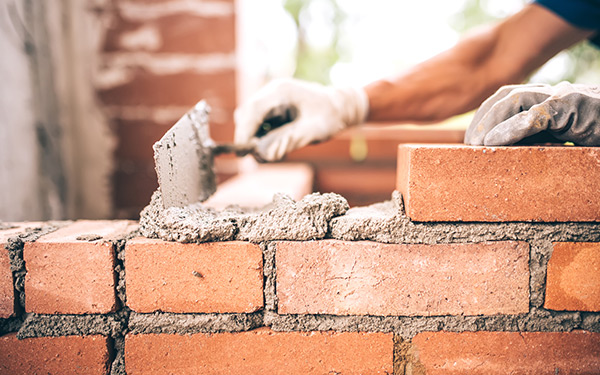Opening the Secrets of Lasting Stonework Building And Construction Practices for Eco-Friendly Buildings
Amongst the myriad techniques to environment-friendly structure, sustainable stonework construction stands out as a reliable and resilient method that holds a wealth of untapped possibility. From the choice of materials to ingenious building and construction methods, the tricks to accomplishing sustainability within masonry construction are diverse and appealing.
Advantages of Lasting Masonry Building And Construction
Embracing sustainable stonework construction methods not just lowers environmental influence yet also provides long-term economic benefits to contractors and communities. By using products like recycled blocks, obstructs, and stones, builders can significantly lower the carbon footprint of their jobs while advertising resource effectiveness. Furthermore, lasting masonry construction methods, such as appropriate insulation and thermal mass residential properties, can boost power efficiency within buildings, resulting in lowered operational costs in time.
Additionally, the longevity and durability of stonework frameworks add to long-lasting financial advantages. Buildings built making use of lasting stonework practices commonly need much less upkeep and repair, equating to set you back financial savings for contractors and homeowner. The long life of stonework materials additionally makes certain that structures stay steady and secure, lowering the requirement for frequent restorations or substitutes.
Eco-Friendly Masonry Materials
Using environmentally friendly stonework products is a critical action in the direction of boosting the sustainability of construction methods and decreasing environmental influence while maximizing long-lasting financial benefits. Sustainable stonework materials are sourced, created, and utilized in a way that reduces general ecological impact. Products such as recycled blocks, reclaimed stone, and lasting concrete blocks are ending up being increasingly preferred selections for eco-conscious building contractors. Recycled bricks, for example, not just draw away waste from land fills yet likewise need less power to generate compared to new blocks. Reclaimed rock offers an unique visual appeal while reducing the requirement for new quarrying. Sustainable concrete obstructs integrate recycled aggregates and may include better insulation properties, adding to power performance in buildings.
Furthermore, natural materials like adobe, rammed earth, and straw bales offer excellent thermal mass residential properties, reducing the need for heating and cooling down energy. These materials are commonly in your area available, advertising local economic situations and lowering transportation-related carbon emissions. By choosing green stonework materials, building tasks can significantly lower their ecological impact and add to the development of much healthier, extra sustainable constructed environments.
Energy-Efficient Masonry Strategies
Energy effectiveness plays a critical duty useful reference in boosting the sustainability of masonry construction practices. One vital energy-efficient stonework method is the usage of thermal mass, which includes incorporating thick materials like concrete or block right into the structure's framework to soak up and save warmth.

Developments in Sustainable Masonry
Current advancements in sustainable masonry techniques have caused ingenious strategies that are improving the building and construction market. One such technology is the growth of self-healing concrete, which uses bacteria embedded within the concrete to recover fractures autonomously. This breakthrough not just minimizes maintenance prices however also boosts the toughness interior stamped concrete of masonry frameworks, adding to their sustainability.
One more notable technology is using recycled accumulations in masonry building and construction - masonry contractor. By incorporating products such as crushed ceramic waste or recycled glass right into concrete blends, contractors can decrease the environmental influence of construction projects while preserving structural stability. This method not just draws away waste from land fills yet additionally conserves natural deposits, making it a key development in sustainable masonry building
Moreover, the assimilation of electronic layout devices, such as Structure Details Modeling (BIM), is revolutionizing the method masonry frameworks are intended and constructed. BIM enables even more exact estimations, minimized material wastefulness, and boosted power performance, ultimately bring about more lasting structure practices. These innovations collectively signify an encouraging future for sustainable stonework construction in the age of environmentally friendly structures.
Future Trends in Stonework Sustainability
With the cutting-edge strides made in sustainable masonry techniques, the future trends in stonework sustainability are poised to further reinvent the building sector. Among the essential patterns forming the future anchor of stonework sustainability is the increased integration of innovation. Improvements such as Structure Info Modeling (BIM) and online truth simulations are being used to maximize stonework building processes, causing minimized product waste and enhanced energy efficiency in buildings.
Additionally, the development of novel sustainable products is established to play a substantial function in enhancing the eco-friendliness of stonework building and construction. masonry contractor. Innovations like self-healing concrete, recycled aggregates, and bio-based binders are acquiring traction for their ability to minimize ecological influence while preserving structural stability

Verdict
To conclude, sustainable stonework building techniques supply countless advantages for environmentally friendly buildings. By using environmentally friendly materials and energy-efficient methods, masonry can add to a more sustainable built environment. Innovations in sustainable masonry are continuously being developed to further enhance the ecological efficiency of buildings. Looking in the direction of the future, the fad of stonework sustainability is expected to grow, resulting in more environmentally friendly and energy-efficient construction techniques in the years ahead.